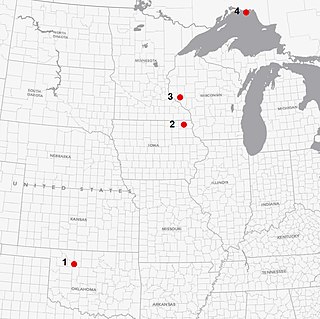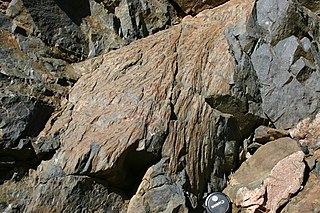
An impact crater is a circular depression in the surface of a solid astronomical object formed by the hypervelocity impact of a smaller object. In contrast to volcanic craters, which result from explosion or internal collapse, impact craters typically have raised rims and floors that are lower in elevation than the surrounding terrain. Lunar impact craters range from microscopic craters on lunar rocks returned by the Apollo program and small, simple, bowl-shaped depressions in the lunar regolith to large, complex, multi-ringed impact basins. Meteor Crater is a well-known example of a small impact crater on Earth.

A meteorite is a solid piece of debris from an object, such as a comet, asteroid, or meteoroid, that originates in outer space and survives its passage through the atmosphere to reach the surface of a planet or moon. When the original object enters the atmosphere, various factors such as friction, pressure, and chemical interactions with the atmospheric gases cause it to heat up and radiate energy. It then becomes a meteor and forms a fireball, also known as a shooting star; astronomers call the brightest examples "bolides". Once it settles on the larger body's surface, the meteor becomes a meteorite. Meteorites vary greatly in size. For geologists, a bolide is a meteorite large enough to create an impact crater.

Meteor Crater or Barringer Crater is a meteorite impact crater about 37 mi (60 km) east of Flagstaff and 18 mi (29 km) west of Winslow in the desert of northern Arizona, United States. The site had several earlier names, and fragments of the meteorite are officially called the Canyon Diablo Meteorite, after the adjacent Canyon Diablo.

An impact event is a collision between astronomical objects causing measurable effects. Impact events have physical consequences and have been found to regularly occur in planetary systems, though the most frequent involve asteroids, comets or meteoroids and have minimal effect. When large objects impact terrestrial planets such as the Earth, there can be significant physical and biospheric consequences, though atmospheres mitigate many surface impacts through atmospheric entry. Impact craters and structures are dominant landforms on many of the Solar System's solid objects and present the strongest empirical evidence for their frequency and scale.

Glasford is a village in Peoria County, Illinois, United States. The population was 866 at the 2020 census. Glasford is part of the Peoria, Illinois Metropolitan Statistical Area.

Ames crater is a meteorite crater (astrobleme) in Major County, Oklahoma, United States. Ames, Oklahoma is near the center of the structure, which is 30 miles (48 km) southwest of Enid, Oklahoma. Buried under a thick layer of sediment, it was not discovered until 1991. Subsequent drilling within the crater found a large amount of oil and gas. It is one of the largest of six meteor craters associated with oil-producing formations in the United States.

Kaali is a group of nine meteorite craters in the village of Kaali on the Estonian island of Saaremaa. Most recent estimates put its formation shortly after 1530–1450 BC. It was created by an impact event and is one of the few impact events that has occurred in a populated area.

The Kentland structure, also known as the Kentland crater or the Kentland disturbed area, is an impact structure located near the town of Kentland in Newton County, Indiana, United States.

Lappajärvi is a lake in Finland, in the municipalities of Lappajärvi, Alajärvi and Vimpeli. It is formed in a 23 km (14 mi) wide, partly eroded meteorite impact crater. The lake is part of Ähtävänjoki basin together with Lake Evijärvi that is located downstream (north) of it.

Neugrund is a meteorite crater in Estonia. It is 8 km (5.0 mi) in diameter and was previously estimated to have been formed in the Ordovician around 470 Ma, with later research revealing a possible Cambrian origin. The crater is at the bottom of the sea and is not exposed at the surface. Boulders of gneissic breccia found on the coast of Osmussaar, a nearby island, are believed to have been thrown there by the explosion. It has been proposed that the Neugrund crater was created during the Ordovician meteor event when a hypothetical large asteroid transferred directly into a resonant orbit with Jupiter, which shifted its orbit to intercept Earth.

The Rock Elm Disturbance is an impact crater in Pierce County, Wisconsin, United States, roughly 40 kilometres (25 mi) southwest of Menomonie. The disturbance is named for Rock Elm, Wisconsin, a nearby town.

Sierra Madera crater is a meteorite crater (astrobleme) in southwestern Pecos County, Texas, United States. The central peak of the rebound structure of the impact crater rises 793 ft (242 m) above the surrounding land. The peak is visible from U.S. Highway 385 between Fort Stockton, Texas and Marathon, Texas. The Sierra Madera crater is located on private property on the La Escalera Ranch.

Grove Karl Gilbert, known by the abbreviated name G. K. Gilbert in academic literature, was an American geologist.
In geology, a cryptoexplosion structure is an explosion of unknown cause. The term is now largely obsolete. It was once commonly used to describe sites where there was geological evidence of a large-scale explosion within the Earth's crust, but no definitive evidence for the cause such as normal volcanic rocks. These sites are usually circular with signs of anomalous rock deformation contrasting with the surrounding region, and often showing evidence that crustal material had been uplifted and/or blown outwards. The assumption was that some unusual form of volcanism, or a gas explosion originating within the crust, was the cause. The use of the term went away with the rise of the science of impact crater recognition in the late 20th century. Most structures described as cryptoexplosions turned out to be eroded impact craters, caused by the impact of meteorites. Today geologists discount former cryptoexplosion theories.

The Canyon Diablo meteorite refers to the many fragments of the asteroid that created Meteor Crater, Arizona, United States. Meteorites have been found around the crater rim, and are named for nearby Canyon Diablo, which lies about three to four miles west of the crater.
The geology of Illinois includes extensive deposits of marine sedimentary rocks from the Palaeozoic, as well as relatively minor contributions from the Mesozoic and Cenozoic. Ice age glaciation left a wealth of glacial topographic features throughout the state.

The Santa Fe impact structure is an eroded remnant of a bolide impact crater in the Sangre de Cristo Mountains northeast of Santa Fe, New Mexico. The discovery was made in 2005 by a geologist who noticed shatter cones in the rocks in a decades-old road cut on New Mexico State Road 475 between Santa Fe and Hyde Memorial State Park. Shatter cones are a definitive indicator that the rocks had been exposed to a shock of pressures only possible in a meteor impact or a nuclear explosion.

The Ordovician meteor event was a dramatic increase in the rate at which L chondrite meteorites fell to Earth during the Middle Ordovician period, about 467.5±0.28 million years ago. This is indicated by abundant fossil L chondrite meteorites in a quarry in Sweden and enhanced concentrations of ordinary chondritic chromite grains in sedimentary rocks from this time. This temporary increase in the impact rate was most likely caused by the destruction of the L chondrite parent body 468 ± 0.3 million years ago having scattered fragments into Earth-crossing orbits, a chronology which is also supported by shock ages in numerous L chondrite meteorites that fall to Earth today. It has been speculated that this influx contributed to, or possibly even instigated, the Great Ordovician Biodiversification Event, although this has been questioned.


















